






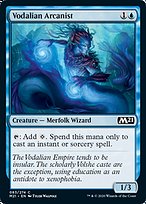





















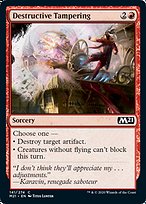




































Core Set 2021 is a core set with 101 commons, 80 uncommons, 53 rares, 15 mythic rares, three variations of each standard basic land, and 10 extra common lands that can replace basic lands in boosters. This is the normal size for a large set of this era (although extra common lands don't appear in every set). Foil cards are included in booster packs with advertised odds of 1 : 45 cards. The set was printed in English in the USA, Belgium, and Japan.
Core Set 2021 was sold in 15 card booster packs (which contain an additional ad card). Booster boxes have 36 packs.
There are two different US pack formats. One, which I will call "classic" similar to previous US printings of normal large sets (for instance, Ikoria). The other is the "new" format first seen in Modern Horizons (although it has evolved somewhat, perhaps to accomodate other changes). The most obvious difference is that the new format has the rare first and commons last (compared to the reverse in classic packs).
The classing US printing uses sequential collation with C1/C2 common collation.
Packs have back-facing cards with common-uncommon-rare ordering followed by a basic land or tap land and ad card. If there is a foil, it will displace a common and appear after the rare. If there is a borderless card besides one of the borderless planeswalkers, it will appear in the foil slot.
| 10 Commons | 3 Uncommons | 1 Rare | 1 Land | 1 Ad Card | |
| 9 Commons | 3 Uncommons | 1 Rare | 1 Foil | 1 Land | 1 Ad Card |
Packs are evenly split between C1 commons and C2 commons. C1 packs will contain 2×A + 2×B + 6×C or 3×A + 2×B + 5×C. C2 packs will contains 4×A + 2×B + 4×C or 4×A + 3×B + 3×C or 4×A + 4×B + 2×C. Cards that have showcase variants appear in B or C2 and the showcase variant replaces one of the three copies of the card on the sheet.
| A | A | B | B | C1 | C1 | C1 | C1 | C1 | C1 |
| A | A | A | B | B | C1 | C1 | C1 | C1 | C1 |
| A | A | A | A | B | B | C2 | C2 | C2 | C2 |
| A | A | A | A | B | B | B | C2 | C2 | C2 |
| A | A | A | A | B | B | B | B | C2 | C2 |
When a foil appears in a pack, it will displace a common card. Common foils (including non-showcase basic lands and tap lands) displace A commons. Uncommon foils can appear in both C1 and C2 packs (probably at equal rates) and displace B commons. Rare foils displace C2 commons. Foil showcase cards displace C1 commons. Bordless non-planeswalker cards are in the showcase foil slot, also displacing C1 commons. (Probably they can not appear in the same pack as a foil.)
There are 126 cards that can appear in the common foil slot, so they don't all appear on the same sheet. I don't have information yet about their distribution.
The data is consistent with a common foil rate of 1/6 and an uncommon foil rate of 1/12.
There are two uncommon runs, A and B, each with 40 different cards appearing three times each. Half of packs have two A cards followed by a B, and half have one A card followed by two B cards. For cards that have showcase variants, one of the copies on the sheet is the showcase variant.
There are probably four rare runs. One run contains the normal version of every rare and mythic rare card except for Teferi, Master of Time (with mythic rares appearing half as often in the run). Another run contains every card except for the planeswalkers. In this run, cards with showcase versions appear only as their showcase versions. (This is different than Ikoria because the showcase rare cards do not need to be gutter cut.) The third run contains the showcase and borderless planeswalkers except for Teferi. The last run contains all the versions of Teferi. The first run apparently appears 17/26 of the time. This is slightly less than 2/3. (Some of this discrepancy may be because Teferi isn't in this run, but this doesn't fully justify it.) The reprints with borderless alternate art reprint variants (where those variants, as already noted, appear in the foil slot instead of the rare slot) don't seem to have any special treatment in this collation scheme, so their normal versions are probably equally as rare as normal cards of the same rarity. For other cards, it appears that they are all about equally likely overall when including the showcase and/or bordless versions (with mythic rare cards half as likely). For the planeswalkers, the showcase and borderless versions combined make up about 1/3 of the total copies (although this number isn't totally certain, it should be close). I don't know the breakdown between showcase and borderless. For non-planeswalkers, the showcase versions make up about 1/3 of the copies. For Teferi, everything is more speculative since his sheet has such low as-fan.
Cards in the land slot come from one sheet. Basic lands appear 1/2 of the time, each appearing 3 times on the sheet including the showcase variant which is just as common as any other basic land variation. Each of the tap lands appears 6 times on the sheet.
The A common run consists of 33 different cards each appearing twice. These cards are white, blue, and red (appearing in that order). The choice of first card is mostly arbitrary.
 |  |  |  |  |  |  |  |  |  |  |
 |  |  |  |  |  |  |  |  |  |  |
 |  |  |  |  |  |  |  |  |  |  |
 |  |  |  |  |  |  |  |  |  |  |
 |  |  |  |  |  |  |  |  |  |  |
 |  |  |  |  |  |  |  |  |  |  |
The B common run consists of 22 different cards each appearing three times. The cards alternate between black and green. For cards with showcase versions, one of the three copies is the showcase version. The choice of first card is mostly arbitrary.
 |  |  |  |  | 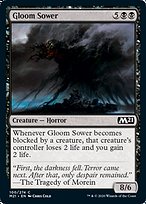 |  |  |  |  |  |
 |  |  | 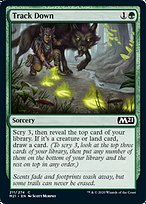 |  |  |  |  |  |  |  |
 |  |  |  |  |  |  |  |  |  |  |
 |  |  |  |  |  |  |  |  |  |  |
 |  |  |  |  |  |  |  |  |  |  |
 |  |  |  |  |  |  |  |  |  |  |
The C1 common run consists of 27 different cards each appearing twice plus Silent Dart, the short-printed common. It includes cards of all colors and colorless cards. The choice of first card is mostly arbitrary.
 |  |  |  | 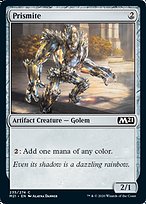 | 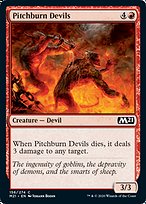 |  |  | 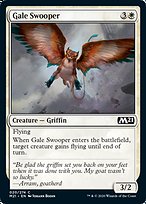 |  |  |
 |  |  |  |  | 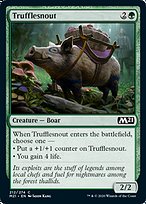 |  |  |  |  | 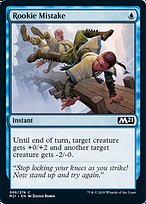 |
 |  |  |  |  |  |  |  |  |  |  |
 |  |  |  |  |  |  |  |  |  |  |
 |  |  |  |  |  |  |  |  |  |  |
The C2 common run consists of 18 different cards each appearing three times plus Silent Dart, the short-printed common. It includes cards of all colors and colorless cards. For cards with showcase versions, one of the three copies is the showcase version. The choice of first card is mostly arbitrary.
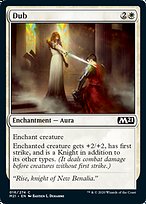 |  |  |  |  |  |  |  |  |  |  |
 |  |  |  |  |  |  |  |  |  | 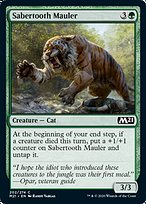 |
 |  |  |  |  |  |  |  |  |  |  |
 |  |  |  |  |  |  |  |  |  |  |
 |  |  |  |  |  |  |  |  |  |  |
The A uncommon run consists of 40 different cards each appearing three times. For cards that have showcase variants, one of the copies on the sheet is the showcase variant. The choice of first card is mostly arbitrary.
 |  |  |  | 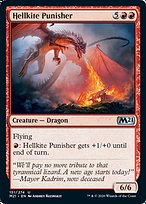 |  |  |  |  |  | 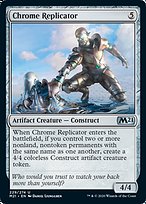 |
 |  |  |  | 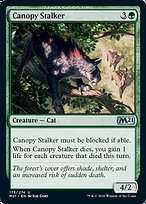 |  |  |  |  | 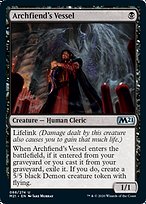 |  |
 |  |  |  |  | 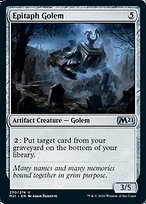 |  | 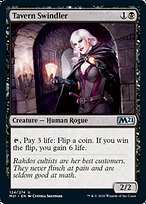 |  |  |  |
 |  |  |  |  |  |  |  |  |  | 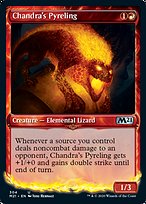 |
 |  |  |  |  |  |  |  |  |  |  |
 |  |  |  |  | 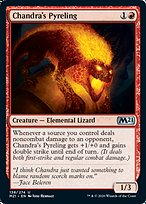 |  |  |  |  |  |
 |  |  |  |  |  |  |  |  |  |  |
 |  |  |  |  |  |  |  |  |  |  |
 |  |  |  |  |  |  |  |  |  |  |
 |  |  |  |  |  |  |  |  |  |  |
 |  |  |  |  |  |  |  |  |  |
The B uncommon run also consists of 40 different cards each appearing three times. For cards that have showcase variants, one of the copies on the sheet is the showcase variant. The choice of first card is mostly arbitrary.
 | 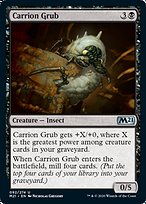 |  |  |  |  | 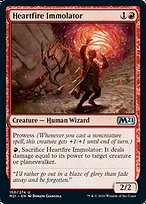 |  |  |  | 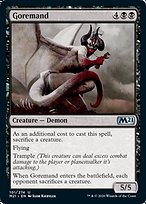 |
 |  |  |  |  | 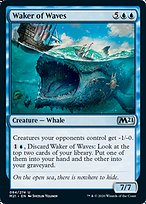 |  |  |  | 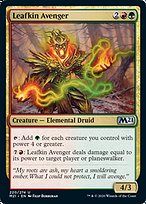 |  |
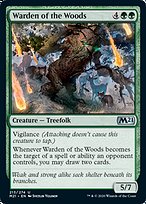 |  |  |  |  |  |  |  |  |  |  |
 |  |  |  |  |  |  |  | 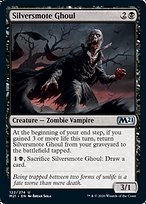 |  |  |
 |  |  |  |  |  |  |  |  |  |  |
 |  |  |  |  |  |  |  |  |  |  |
 |  |  |  |  |  |  |  |  |  |  |
 |  |  |  |  |  |  |  |  |  |  |
 |  |  |  |  |  |  |  |  |  |  |
 |  |  |  |  |  |  |  |  |  |  |
 |  |  |  |  |  |  |  |  |  |
Each basic land appears 3 times (including the showcase variants) and each tap land appears 6 times. The choice of first card is mostly arbitrary.
 |  |  |  |  |  | 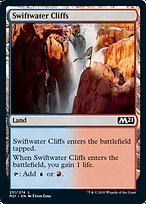 |  |  |  |  |
 |  | 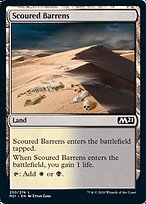 |  |  |  |  |  |  |  |  |
 |  |  | 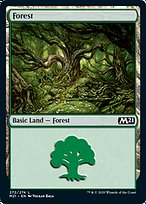 |  |  |  | 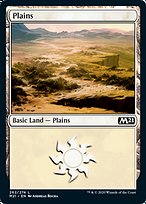 |  |  |  |
 |  |  |  |  |  |  |  |  |  |  |
 |  |  |  |  |  |  |  |  |  |  |
 |  |  |  |  |  |  |  |  |  |  |
 |  |  |  |  |  |  |  |  |  |  |
 |  |  |  |  |  |  |  |  |  |  |
 |  |  |  |  |  |  |  |  |  |  |
 |  |  |  |  |  |  |  |  |  |  |
 |  |  |  |  |  |  |  |  |  |
Most of the marketing cards in Core Set 2021 have a token or emblem on the front face. In addition, there is a card that has an advertisement for MTG Arena on the front face. (The front has an ESRB rating and the back has PEGI, so I'm not aware of any region differences.) They are printed on an 11 × 11 sheet with different items appearing different numbers of times.
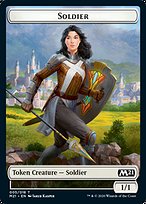 |  | 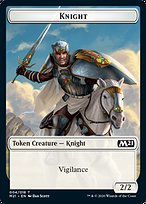 |  |  |  |  |  |  |  |  |
 |  |  |  |  |  |  |  |  |  |  |
 |  |  |  |  |  |  |  |  |  |  |
 |  |  |  |  |  |  |  |  |  |  |
 |  |  |  |  |  |  |  |  |  |  |
 |  |  |  |  |  |  |  |  |  |  |
 |  |  |  |  |  |  | 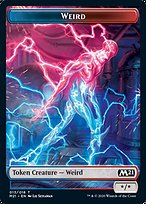 |  |  |  |
 |  |  |  |  |  |  |  |  |  |  |
 |  |  |  |  |  |  |  |  |  |  |
 |  |  |  |  |  |  |  |  |  |  |
 |  |  |  |  |  |  |  |  |  |  |
| Token Rarity | ||
|---|---|---|
 Basri Ket Emblem × 1 Basri Ket Emblem × 1 |  Garruk, Unleashed Emblem × 1 Garruk, Unleashed Emblem × 1 |  Liliana, Waker of the Dead Emblem × 1 Liliana, Waker of the Dead Emblem × 1 |
 Construct × 2 Construct × 2 |  Pirate × 2 Pirate × 2 | 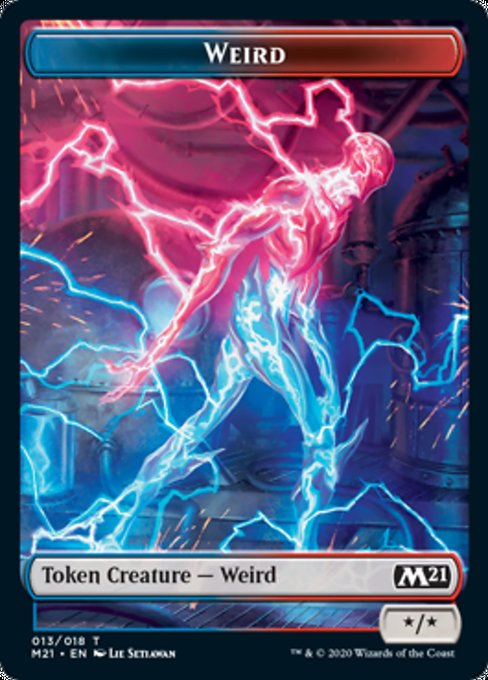 Weird × 2 Weird × 2 |
 Treasure × 3 Treasure × 3 |  Demon × 4 Demon × 4 |  Angel × 6 Angel × 6 |
 Bird × 6 Bird × 6 |  Cat × 6 Cat × 6 |  Griffin × 7 Griffin × 7 |
 Beast × 8 Beast × 8 |  Goblin Wizard × 8 Goblin Wizard × 8 | 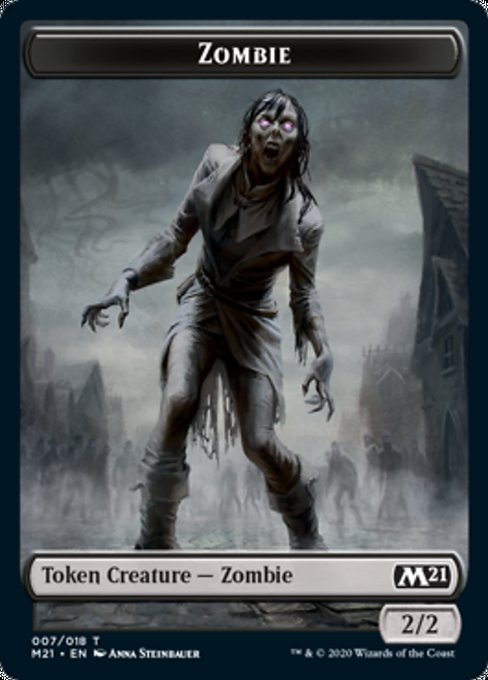 Zombie × 8 Zombie × 8 |
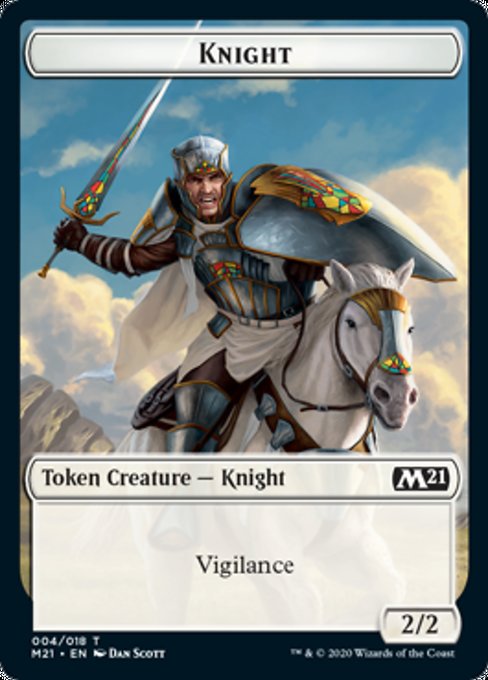 Knight × 12 Knight × 12 | 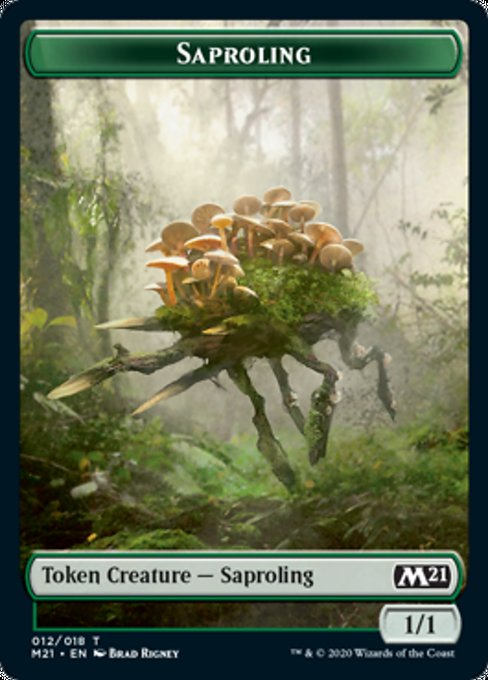 Saproling × 12 Saproling × 12 |  Soldier × 12 Soldier × 12 |
 Arena Ad Card × 20 Arena Ad Card × 20 | ||
The new US printing uses sequential collation with heavily modified C1/C2 common collation.
Packs are front-facing and have an ad/token card, and a basic snow land followed by a rare, three uncommons, and ten commons. If there is a foil card, it will appear before the rare, displacing a common. If there is a borderless card besides one of the borderless planeswalkers, it will appear in the foil slot. (This is the reverse of classic US pack order.)
| 1 Ad Card | 1 Land | 1 Rare | 3 Uncommons | 10 Commons | |
| 1 Ad Card | 1 Land | 1 Foil | 1 Rare | 3 Uncommons | 9 Commons |
The print runs (and probably the sheets) are the same as those for the classic US printing, except the order is reversed (possibly as a result of back cutting).
Like most C1/C2 sets (but in contrast to the new style Modern Horizons printing), C1 and C2 packs are equally likely. C1 packs normally contain 5-6 C cards followed by 2 B cards and 2-3 A cards. C2 packs normally contain 3-4 C cards followed by 2-3 B and 4 A. In C1 packs with a foil (or a borderless alternate art reprint), the only observed pack type is 5-2-2. In C2 packs with a foil, it is possible to get only 3 A cards. Observed packs are 4-2-3, 3-3-3, and 3-2-4. Foils are more likely to appear in C2 packs.
Using the 3:2 constraint between the commons sheets and the total foil rate (here assumed to be 1/3, but in reality this should be boosted by the non-foil borderless reprint rate), we can directly calculate the rate of C2 3-2-4 foil packs as 2/15 (unconditional, so 4/15 conditioned on C2). We can then use the 6:5 sheet constraint to compute the breakdown between 4 C2 and 2 B versus 3 C2 and 3 B (which may or may not be independent of foil appearance). This says 85/121 (about 70%) of such packs should have 4 C2 cards. I don't think sheet math can be used to compute the remaining rates.
For uncommons, half of packs have two A cards followed by a B, and half have one A card followed by two B cards. (This is the same as classic US, and A still comes first even though A and B are individually reversed.)
The Belgian printing uses sequential collation with simple two-run 101 common collation.
Packs are front-facing and have common-uncommon-rare ordering followed by a basic land or tap land and an ad card. There are 10 commons, 3 uncommons, and 1 rare. If there is a foil, it will displace a common and appear after the rare. (This is a change from previous Belgian-printed sets where the foil would appear after the land.) If there is a borderless card besides one of the borderless planeswalkers, it will appear in the foil slot.
| 10 Commons | 3 Uncommons | 1 Rare | 1 Land | 1 Ad Card | |
| 9 Commons | 3 Uncommons | 1 Rare | 1 Foil | 1 Land | 1 Ad Card |
Each pack contains six cards from the A common run followed by four cards from the B run. Foils can displace a card from either run.
The A common run consists of 60 different cards each appearing twice plus Silent Dart, the short-printed common. The cards are mostly non-white. The choice of first card is mostly arbitrary.
 |  |  |  |  |  |  |  |  |  |  |
 |  |  |  |  |  |  |  |  |  |  |
 |  |  |  |  |  |  |  |  |  |  |
 |  |  |  |  |  |  |  |  |  |  |
 |  |  |  |  |  |  |  |  |  |  |
 |  |  |  |  |  |  |  |  |  |  |
 |  |  |  |  |  |  |  |  |  |  |
 |  |  |  |  |  |  |  |  |  |  |
 |  |  |  |  |  |  |  |  |  |  |
 |  |  |  |  |  |  |  |  |  |  |
 |  |  |  |  |  |  |  |  |  |  |
The B common run consists of 40 different cards each appearing three times plus Silent Dart, the short-printed common. It includes cards of all colors and colorless cards, but more white cards than other colors. For cards that have a showcase variant, one of the three copies is the showcase version. The choice of first card is mostly arbitrary.
 |  |  |  |  |  |  |  |  |  |  |
 |  |  |  |  |  |  |  |  |  |  |
 |  |  |  |  |  |  |  |  |  |  |
 |  |  |  |  |  |  |  |  |  |  |
 |  |  |  |  |  |  |  |  |  |  |
 |  |  |  |  |  |  |  |  |  |  |
 |  |  |  |  |  |  |  |  |  |  |
 |  |  |  |  |  |  |  |  |  |  |
 |  |  |  |  |  |  |  |  |  |  |
 |  |  |  |  |  |  |  |  |  |  |
 |  |  |  |  |  |  |  |  |  |  |
The Japanese printing uses sequential collation with (probably) 112 card sheets (which seems to be the usual for Japan). The dimensions of the sheets are not known.
Packs are front-facing starting with the ad card and a basic land or common tap land, then the rare, 3 uncommons, and 10 commons. If there is a foil, it will appear between the land and the rare, displacing a common. If there is a non-foil borderless card besides one of the borderless planeswalkers, it will appear after the rare, also displacing a common. (Probably they cannot appear in the same pack, but this isn't confirmed.)
| 1 Ad Card | 1 Land | 1 Rare | 3 Uncommons | 10 Commons | |
| 1 Ad Card | 1 Land | 1 Foil | 1 Rare | 3 Uncommons | 9 Commons |
| 1 Ad Card | 1 Land | 1 Rare | 1 Borderless Reprint | 3 Uncommons | 9 Commons |
There are 3 common runs: A, B, and C. A contains 27 distinct cards, and B and C each contain 37 distinct cards. Each pack gets 2 to 3 cards from A followed by 3 to 4 cards from B and 3 to 4 cards from C. This means packs are either 2-4-4, 3-3-4, or 3-4-3. The exact ratios may depend on the way foil collation works. The cards with showcase versions appear in run C where the showcase version takes up one of the card's three slots in the run.
| A | A | B | B | B | B | C | C | C | C |
| A | A | A | B | B | B | C | C | C | C |
| A | A | A | B | B | B | B | C | C | C |
Foils displace a common. As far as I've seen, there will still be at least 2 A commons, 3 B commons, and 3 C commons, and I have seen all three possibilities for common distribution given a foil. Non-foil borderless reprints work similarly.
The A common run consists of 27 different cards each appearing four times (which would leave 4 fillers on a 112 card sheet). The cards are mostly black. The choice of first card is mostly arbitrary.
 |  |  |  |  |  |  |  |
 |  |  |  |  |  |  |  |
 |  |  |  |  |  |  |  |
 |  |  |  |  |  |  |  |
 |  |  |  |  |  |  |  |
 |  |  |  |  |  |  |  |
 |  |  |  |  |  |  |  |
 |  |  |  |  |  |  |  |
 |  |  |  |  |  |  |  |
 |  |  |  |  |  |  |  |
 |  |  |  |  |  |  |  |
 |  |  |  |  |  |  |  |
 |  |  |  |  |  |  |  |
 |  |  |  |
The B common run consists of 37 different cards each appearing three times (which would leave 1 filler on a 112 card sheet). The cards are mostly white and blue. The choice of first card is mostly arbitrary.
 |  |  |  |  |  |  |  |
 |  |  |  |  |  |  |  |
 |  |  |  |  |  |  |  |
 |  |  |  |  |  |  |  |
 |  |  |  |  |  |  |  |
 |  |  |  |  |  |  |  |
 |  |  |  |  |  |  |  |
 |  |  |  |  |  |  |  |
 |  |  |  |  |  |  |  |
 |  |  |  |  |  |  |  |
 |  |  |  |  |  |  |  |
 |  |  |  |  |  |  |  |
 |  |  |  |  |  |  |  |
 |  |  |  |  |  |  |
The C common run consists of 37 different cards each appearing three times (which would leave 1 filler on a 112 card sheet). The cards are mostly red and green. For cards that have showcase variants, one of the copies on the sheet is the showcase variant. The choice of first card is mostly arbitrary.
 |  |  |  |  |  |  |  |
 |  |  |  |  |  |  |  |
 |  |  |  |  |  |  |  |
 |  |  |  |  |  |  |  |
 |  |  |  |  |  |  |  |
 |  |  |  |  |  |  |  |
 |  |  |  |  |  |  |  |
 |  |  |  |  |  |  |  |
 |  |  |  |  |  |  |  |
 |  |  |  |  |  |  |  |
 |  |  |  |  |  |  |  |
 |  |  |  |  |  |  |  |
 |  |  |  |  |  |  |  |
 |  |  |  |  |  |  |